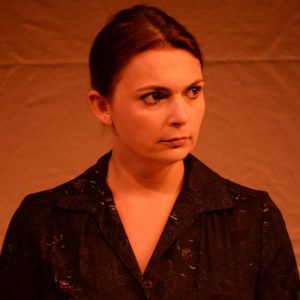

When tragedy happens, survivors and family members of victims often become obsessed with finding out who was at fault. Who let this horrible thing happen? One such tragedy occurred during WW2 when 173 people were crushed to death in the air raid shelter of London’s Bethnal Green tube station. Not by bombs, but by each other. How did it happen? Who was at fault, and why did the official government report keep so much information hidden? Finally, are there such things as simple answers? These are the questions posed by Martin Casella’s play The Report, presented by Cutting Hedge Productions as part of the New York International Fringe Festival.
The play, based on a novel by Jessica Francis Kane, is very well crafted, if a bit overlong. Casella has quite effectively created the atmosphere of London during the war and he has developed several interesting characters, each of whom have a story to tell. Michael Countryman plays Metropolitan magistrate Laurence Dunne, the head of the investigation into the cause of the catastrophe. Devoted to finding the truth, he must wade through the pain and conflicted memories of the victims as well as a quagmire of political beadledom. In the end, he finds himself in the unenviable position of gatekeeper of the truth, and must decide what is best for the community he is serving.
The Report is exceptionally well staged by director Alan Muraoka (with Specialty Movement by Darren Lee). This is a real theater piece instead of an attempt at live cinema. The action is very clear despite the shifting of time; the play moves back and forth between the tragedy and a BBC documentary done thirty years later. This “tell me what happened” technique might seem like cliché, but here the playwright has given the documentarian, played by Stuart Williams, a special connection to the tragedy, one that shockingly deepens as he presses his subject, magistrate Dunne, for more information. What he ultimately discovers leaves him shattered.
The tragedy itself is powerfully depicted by a group of actors, perfectly believable as the long-suffering Londoners of 1943. We see them grumpily entering the tube station after air raid sirens are sounded before becoming disoriented in the darkness and then panic-stricken as they are engulfed in confusion and terror. Candles, torches and a magical use of white scrim, which is used to dramatize confusion itself, all serve to create powerful moments of pure theater. Some of the actors shift from character to character, yet there is never any confusion as to who each of them is portraying at any given time.
The cast of actors is quite strong, particularly Zoë Watkins as Ada, a London mother, whose moving story I will not lessen by revealing, and Philippa Dawson, heartbreaking as a young wife who, in the midst of communal grief, is forced to deal with a second tragedy. James Physick is quite wonderful as a priest impotently struggling to help his community deal with this senseless tragedy, occurring almost on the heels of London’s near destruction by Nazi air strikes.
The costume design, by Sesame Street and SNL veteran Brian Hemesath, is outstanding. We get a sense of each character simply by looking at them, and the period atmosphere of London during its unimaginable struggles more than seventy years ago is powerfully yet subtly recreated.
The acoustics of the theater and the low projection of some of the actors make portions of the dialogue difficult to hear, and this is unfortunate. But overall, this is a fascinating story that is grippingly told.